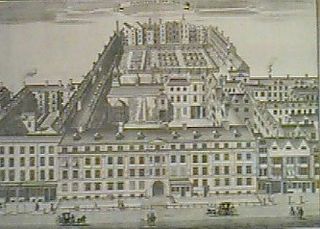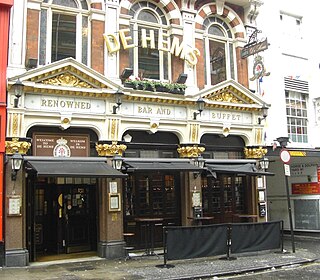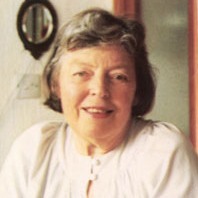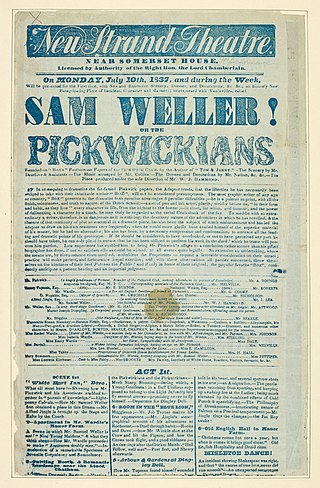
English cuisine encompasses the cooking styles, traditions and recipes associated with England. It has distinctive attributes of its own, but is also very similar to wider British cuisine, partly historically and partly due to the import of ingredients and ideas from the Americas, China, and India during the time of the British Empire and as a result of post-war immigration.

Christmas pudding is sweet, dried-fruit pudding traditionally served as part of Christmas dinner in Britain and other countries to which the tradition has been exported. It has its origins in medieval England, with early recipes making use of dried fruit, suet, breadcrumbs, flour, eggs and spice, along with liquid such as milk or fortified wine. Later, recipes became more elaborate. In 1845, cookery writer Eliza Acton wrote the first recipe for a dish called "Christmas pudding".

The Posthumous Papers of the Pickwick Club was the first novel by English author Charles Dickens. His previous work was Sketches by Boz, published in 1836, and his publisher Chapman & Hall asked Dickens to supply descriptions to explain a series of comic "cockney sporting plates" by illustrator Robert Seymour, and to connect them into a novel. The book became a publishing phenomenon, with bootleg copies, theatrical performances, Sam Weller joke books, and other merchandise. On its cultural impact, Nicholas Dames in The Atlantic writes, "'Literature' is not a big enough category for Pickwick. It defined its own, a new one that we have learned to call 'entertainment'." The Pickwick Papers was published in 19 issues over 20 months, and it popularised serialised fiction and cliffhanger endings.

Steak and kidney pie is a popular British dish. It is a savoury pie filled principally with a mixture of diced beef, diced kidney and onion. Its contents are generally similar to those of steak and kidney puddings.

Pease pudding, also known as pease porridge, is a savoury pudding dish made of boiled legumes, typically split yellow peas, with water, salt and spices, and often cooked with a bacon or ham joint. A common dish in the north-east of England, it is consumed to a lesser extent in the rest of Britain. In Newfoundland, it retains its traditional name as part of the customary Jiggs dinner. In non-English speaking countries, similar dishes exist under different names.

Steak Diane is a dish of pan-fried beefsteak with a sauce made from the seasoned pan juices. It was originally cooked tableside and sometimes flambéed. It was most likely invented in London in the 1930s. From the 1940s through the 1960s it was a standard dish in "Continental cuisine", and is now considered retro.

Pickled walnuts are a traditional English pickle, made from walnuts. They are considered a suitable accompaniment for a dish of cold turkey or ham, as well as blue cheese. There is a reference to "a mutton chop and a pickled walnut" in The Pickwick Papers by Charles Dickens and a mention in Evelyn Waugh’s Brideshead Revisited.

Furnival's Inn was an Inn of Chancery which formerly stood on the site of the present Holborn Bars building in Holborn, London, England.
Mark Ernest Hix is an English chef and restaurateur whose traditional English menus often feature foraged and local foods. Prior to the COVID-19 pandemic, Hix was based in London, but announced in January 2021 that he would be relocating to Dorset permanently after five of his restaurants were put into administration.
Cranks was a chain of English wholefood vegetarian restaurants. It was founded and owned by David and Kay Canter and Daphne Swann, and its flagship restaurant was at Marshall Street in the West End of London.

The Oriental Club in London is a Private Members’ Club established in 1824. Charles Graves described it in 1963 as fine in quality as White's but with the space of infinitely larger clubs. It is now located in Stratford Place, near Oxford Street and Bond Street. Based in an elegant building, the Oriental Club is one of the best members’ clubs for those in their 20s.

De Hems is a café, pub and oyster-house in the Chinatown area of London just off Shaftesbury Avenue. It made its name purveying oysters and now sells beers from the Low countries such as Grolsch and Heineken with Dutch food such as bitterballen and frikandellen.

Cedric David Charles Dickens was an English author and businessman, a great-grandson of Charles Dickens and the steward of his literary legacy. He was a lifelong supporter of the Charles Dickens Museum in Holborn, London, and twice President of the Dickens Fellowship.
The Abernethy biscuit was invented by surgeon John Abernethy in the 18th century as a digestive improver.

Charles Dickens's works are especially associated with London, which is the setting for many of his novels. These works do not just use London as a backdrop but are about the city and its character.

The cuisine of Mauritius is greatly influenced by the tropical location of the island as well as the cultural diversity which characterizes the country. Mauritian cuisine is a blend of African, Chinese, European and Indian influences in the history of Mauritius. Most of the dishes and culinary traditions are inspired by French culture, former African slaves, Indian workers and Chinese migrants that arrived in the country during the 19th century. Over the years, communities found in Mauritius have adapted and mixed each other's cuisine to their liking, resulting in the development of Mauritian cuisine. While some popular dishes and desserts are consumed by Mauritians of all ethnic groups or communities, there are also forms of cuisines which remain unique to a specific ethnic community due to their ancestral cultural and historical connections. Local food therefore reflects the strong traditional, cultural, and historical influences of each community. French cuisine and Sino-Mauritian cuisine are very popular in Mauritius.
The Epicure's Almanack; or, Calendar of Good Living, was a guide to eating establishments in London, written by Ralph Rylance and published by Longman in 1815. Given the poor reception of the initial printing, there was no effort to pull together any later edition. The book was republished by the British Library in 2013, with extensive commentary by Janet Ing Freeman.

Bobby Freeman was a writer, journalist, television presenter and cook who is known for her writing on Welsh cuisine.

Georgina Hill was an English cookery book writer who wrote at least 21 works. She was born in Kingsdown, Bristol before moving to Tadley, Hampshire in the 1850s. She wrote her first cookery book, The Gourmet's Guide to Rabbit Cooking there in 1859. Within a year she was writing for the Routledge Household Manuals series of books, and she produced several works that specialised on an ingredient, type of food or method of cooking. Her books appear to have sold well, and were advertised in India and the US. Her 1862 work Everybody's Pudding Book was republished as A Year of Victorian Puddings in 2012.

Samuel Weller, or, The Pickwickians is an 1837 comedy in three acts adapted from Dickens's novel The Pickwick Papers by William Thomas Moncrieff. It was first performed at the Royal Strand Theatre in London on 17 July 1837.


















